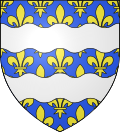Top Qs
Timeline
Chat
Perspective
Seine-et-Marne
Department of France in Île-de-France From Wikipedia, the free encyclopedia
Remove ads
Seine-et-Marne (French pronunciation: [sɛn e maʁn] ⓘ) is a department in the Île-de-France region in Northern France. Named after the rivers Seine and Marne, it is the region's largest department with an area of 5,915 square kilometres (2,284 square miles); it roughly covers its eastern half. In 2019, it had a population of 1,421,197.[4] Its prefecture is Melun, although both Meaux and Chelles have larger populations.
Remove ads
History
This section needs expansion. You can help by adding to it. (February 2024) |
Seine-et-Marne is one of the original 83 departments created on 4 March 1790 during the French Revolution in application of the law of 22 December 1789. It had previously belonged to the former province of Île-de-France. It is the only original departement in the Île-de-France that has remained unchanged, as both Seine and Seine-et-Oise were abolished and reorganised in 1968.[5]
Remove ads
Geography
Summarize
Perspective
Situation

Seine-et-Marne forms a part of the Île-de-France region; the department covers 49% of the region's land area. It is bordered by Val-d'Oise, Seine-Saint-Denis, Val-de-Marne, Essonne to the west; Loiret and Yonne to the south; Aube and Marne to the east; and Aisne and Oise to the north. It is served by RER A, RER B, RER D and RER E amongst other services.
Melun is Seine-et-Marne's prefecture. Fontainebleau, Meaux, Provins and Torcy are its subprefectures. The department comprises part of Paris's outer eastern suburbs; much of Charles de Gaulle Airport sits within its far northwestern boundaries, including a majority of the terminals. The department has many natural reserves, notably Brie and Gâtinais. The department's highest point is butte Saint-George (215 m).
Principal towns
The most populous commune is Meaux; the prefecture Melun is the third-most populous. As of 2019, there are 17 communes with more than 20,000 inhabitants. The 10 most populous communes are:[4]
Climate
Seine-et-Marne has a temperate Atlantic climate. The average rainfall is based upon that of Fontainebleau, giving an average rainfall of 650 mm (25.6 in), which is higher than the average of Île-de-France: 600 mm (23.6 in). Average temperature in Melun during the 1953–2002 period was 3.2 °C (37.8 °F) for January and 18.6 °C (65.5 °F) for July.
The storm of 26 December 1999 led to five deaths in Seine-et-Marne and caused several trees to fall.
Remove ads
Demographics
Summarize
Perspective
People from Seine-et-Marne are known as the Seine-et-Marnais.
Originally Seine-et-Marne was very rural and lightly populated. Over the past 50 years, however, its population has tripled, due to the development of the Paris conurbation and the building of new towns in the northwest of the region. The population was estimated to be 1,267,496 inhabitants in 2006. The region has changed from consisting only of small villages to forming a large part of the Paris conurbation.
Seine-et-Marne as a whole shares a sister city relationship with Orlando, Florida, United States, as both host Disney theme parks.
Remove ads
Economy
With 60 percent of the region used as farmland, Seine-et-Marne is where most agricultural activity occurs within Île-de-France. Cereals and sugar beet are the principal exports from Seine-et-Marne.
The other key industrial structures are the refinery at Grandpuits and the Safran Aircraft Engines research plant at Villaroche. The new town of Marne-la-Vallée is the centre of tourism in Seine-et-Marne in terms of number of visitors, mainly due to the Disneyland Park and Walt Disney Studios Park theme parks at Disneyland Paris.
Remove ads
Politics
Summarize
Perspective
Presidential elections 2nd round
Departmental Council of Seine-et-Marne
The Departmental Council of Seine-et-Marne has 46 seats. Councillors are elected for six-year terms (no term limits) across the department's 23 cantons (two per canton). Since 2021, Jean-François Parigi of The Republicans (LR) has served as President of the Departmental Council.
National representation
In the National Assembly, Seine-et-Marne is represented by:
In the Senate, Seine-et-Marne is represented by:
- Anne Chain-Larché (The Republicans), since 2015
- Pierre Cuypers (The Republicans), since 2016
- Arnaud de Belenet (La République En Marche!), since 2017
- Vincent Éblé (Socialist Party), since 2011
- Colette Mélot (Agir), since 2004
- Claudine Thomas (The Republicans), since 2017
Remove ads
Tourism
- Bilboquet rock formation in the forest of Fontainebleau
- Throne Room in the Palace of Fontainebleau
- The walls of the medieval city of Provins
- Gardens of Vaux-le-Vicomte
See also
Bibliography
- Lion, Christian, La Mutuelle de Seine-et-Marne contre l'incendie de 1819 à 1969. Mutualité, assurance et cycles de l'incendie (Bruxelles etc., Peter Lang, 2008).
References
External links
Wikiwand - on
Seamless Wikipedia browsing. On steroids.
Remove ads














